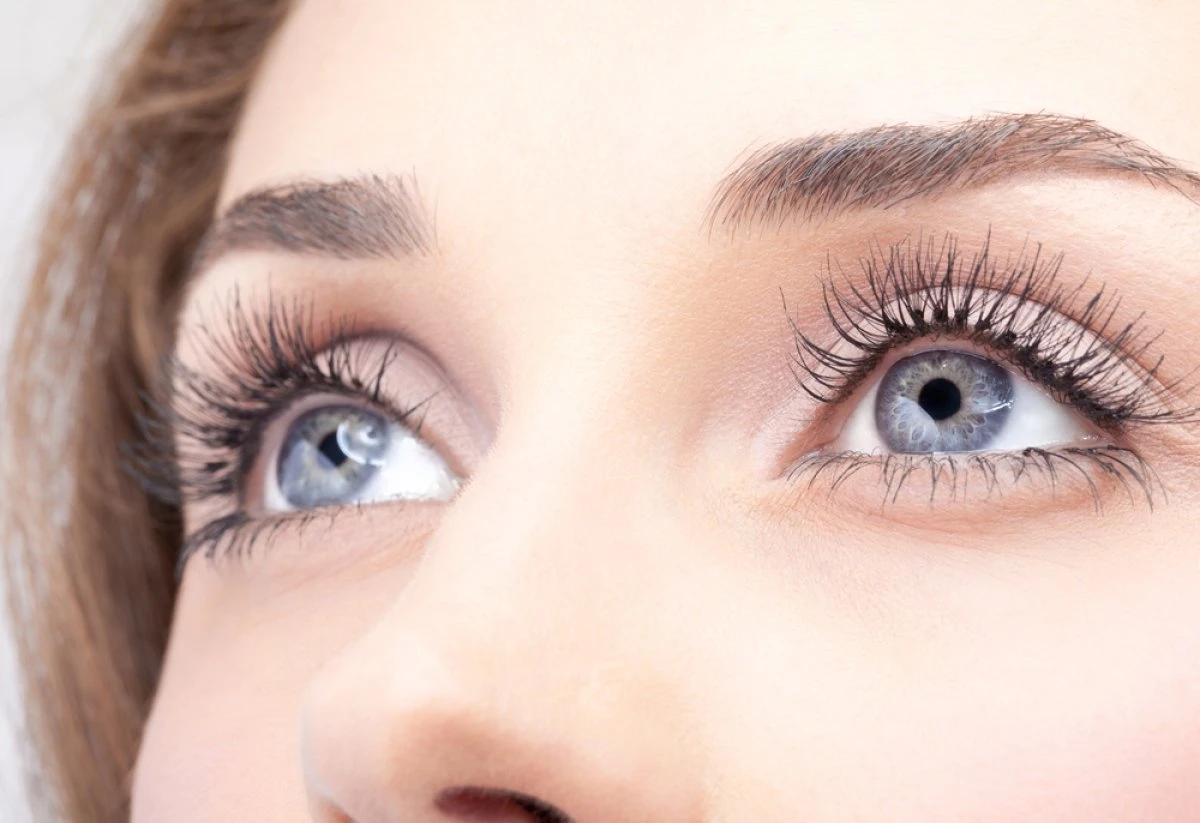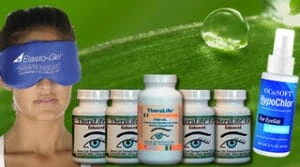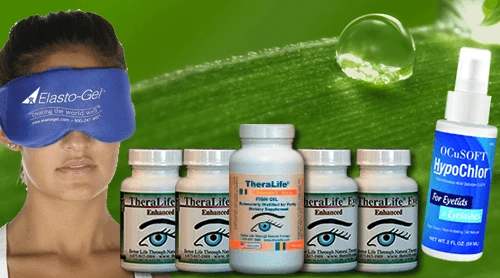While you cannot permanently cure dry eyes, TheraLife’s products offer effective symptom management to significantly improve your quality of life.
Utilizing natural ingredients, TheraLife’s Eye Enhanced formula targets the root causes of dry eyes, such as meibomian gland dysfunction and inflammation, to enhance tear production and quality.
The comprehensive range of TheraLife products, including solutions for blepharitis, uveitis, and chalazion, are designed to address specific eye health issues.
Regular use of these products, combined with lifestyle adjustments like using humidifiers and consuming omega-3 fatty acids, can provide sustained relief.
Additionally, TheraLife recommends regular eye examinations and advanced diagnostic tests to tailor a personalized treatment plan.
Discover more about how TheraLife’s innovative solutions can help you manage dry eyes effectively.
Best All Natural Oral Dry Eye Treatment That Works.
Add To Cart
Key Takeaways
- Theralife.com’s products are designed to effectively manage dry eye disease, providing significant relief even though a permanent cure is not yet available.
- Their treatment options focus on alleviating symptoms and improving tear film stability through innovative therapies.
- Customers can benefit from lifestyle tips, such as staying hydrated and using the 20-20-20 rule, to reduce symptoms significantly.
- Advanced treatments available through your eye doctor, like cyclosporine A and thermal pulsation therapy, target the underlying causes of dry eyes.
- Regular use of Theralife’s oral capsules and punctal plugs can offer continuous relief and enhance eye lubrication for long-term comfort.
Understanding Dry Eye Disease
Dry eye disease, clinically referred to as keratoconjunctivitis sicca, occurs when there’s an imbalance in the tear film, resulting in discomfort and potential vision issues. Understanding dry eye disease requires recognizing its three primary types: aqueous deficient, evaporative, and mixed dry eye. Each type has distinct underlying causes that affect the production and stability of tears.
Aqueous deficient dry eye stems from inadequate tear production by the lacrimal glands. This can be due to autoimmune conditions like Sjogren’s syndrome or damage to the glands.
Evaporative dry eye, on the other hand, results from rapid tear evaporation, often linked to meibomian gland dysfunction, which affects the oily layer of the tear film. Treatments like TheraLife Autoimmune can provide relief for those suffering from dry eyes due to autoimmune conditions.
Mixed dry eye combines elements of both conditions, presenting a more complex challenge.
In the United States, approximately 16 million people suffer from this condition, with a higher prevalence among post-menopausal women and individuals in Asia.
Diagnosing dry eye disease involves a thorough eye examination. Tests such as the Schirmer test measure tear production, while tear breakup time assessments evaluate tear film stability.
Understanding the specific type and underlying cause of your dry eye disease is essential for effective treatment and management.
Common Symptoms of Dry Eyes
Common Symptoms of Dry Eyes
You’ll often notice frequent eye discomfort manifesting as a scratchy or burning sensation, which can feel like there’s something in your eye.
Vision disturbances, such as blurred vision and light sensitivity, are also common and can greatly impact daily activities.
Additionally, you might experience excessive tearing as a paradoxical response to the dryness, especially during prolonged screen use or exposure to irritants like wind and smoke.
Aging and hormonal changes, especially during menopause, can also heighten the risk of developing these symptoms.
Frequent Eye Discomfort
Experiencing frequent eye discomfort often signals the presence of dry eyes, a condition marked by a variety of unsettling symptoms. These dry eye symptoms can severely impact your daily activities and overall comfort. You might notice a persistent stinging or burning sensation, which is a hallmark of dry eyes. Additionally, blurred vision and increased sensitivity to light can make tasks like reading or using screens particularly challenging.
One of the paradoxical symptoms you may encounter is excessive tearing. This occurs as a reflex response to dryness, resulting in a frustrating cycle of both dryness and watery eyes. Another common issue is the sensation of having something in your eye, known as a foreign body sensation, which can contribute to irritation and frustration.
| Symptom | Description | Impact on Daily Life |
|---|---|---|
| Stinging/Burning | Persistent discomfort | Affects overall comfort |
| Blurred Vision | Difficulty seeing clearly | Challenges in reading/screens |
| Excessive Tearing | Reflex tearing in response to dryness | Cycle of dryness and watery eyes |
These symptoms can be exacerbated by factors like low humidity, air conditioning, and prolonged screen time. Understanding these aspects can help you take steps to manage and help relieve dry eye discomfort effectively.
Vision Disturbances
When dealing with dry eyes, vision disturbances often present significant challenges. These disturbances can manifest in several ways, making daily activities more difficult. Blurred vision is a common symptom, especially after extended periods of screen time or exposure to certain environmental factors. This blurriness is often due to increased tear evaporation, which fails to adequately lubricate the eye’s surface.
Another contributing factor is meibomian gland dysfunction, which can exacerbate dryness and lead to inconsistent tear film quality.
Individuals with dry eyes may also experience light sensitivity, making it hard to focus in bright environments or under artificial lighting. Additionally, the sensation of having a foreign body in the eye can lead to frequent blinking and discomfort.
Here are some key symptoms you might experience:
- Blurred vision: This can worsen throughout the day or with prolonged screen use.
- Light sensitivity: Difficulty focusing in bright conditions.
- Foreign body sensation: Persistent feeling of something in the eye, causing discomfort.
- Increased tearing: Paradoxically, dry eyes can trigger excessive tearing, which evaporates quickly, causing transient blurriness.
Fluctuating vision quality is another hallmark of dry eye disease. As the day progresses, you might find your vision becomes increasingly inconsistent, making it harder to maintain focus.
Understanding these symptoms is vital for effective management and seeking appropriate treatment.
Causes of Dry Eye Disease
Understanding the causes of dry eye disease is essential for effective management and treatment. Dry eye disease can stem from insufficient tear production, often linked to age, hormonal changes, or medical conditions that impair tear gland functionality. Rapid tear evaporation, frequently due to meibomian gland dysfunction, can be exacerbated by environmental factors such as wind, smoke, and dry air.
Two primary forms of dry eye are identified: aqueous deficient dry eye, characterized by inadequate tear production, and evaporative dry eye, where poor tear quality leads to tear film instability.
Risk factors include prolonged screen time, certain medications (like antihistamines and antidepressants), and systemic diseases such as diabetes and Sjögren’s syndrome. Approximately 16 million people in the U.S. suffer from dry eye disease, with higher occurrences in post-menopausal women and older adults.
Here’s a quick overview:
| Cause | Description |
|---|---|
| Insufficient Tear Production | Age, hormonal changes, and medical conditions impair tear gland functionality. |
| Meibomian Gland Dysfunction | Poor tear quality and rapid evaporation due to blocked or abnormal oil glands. |
| Environmental Factors | Wind, smoke, and dry air exacerbate tear evaporation. |
| Risk Factors | Screen time, medications, systemic diseases, especially in older adults. |
Diagnostic Methods
Diagnostic Methods
To accurately diagnose dry eye disease, your eye care professional will conduct a thorough eye exam that includes reviewing your medical history and evaluating your symptoms.
Environmental factors, such as dry air and prolonged screen time, can exacerbate symptoms and are often discussed during the exam.
Key diagnostic methods include the Schirmer tear test and tear breakup time (TBUT), which measure tear production and stability, respectively.
Additionally, a slit lamp examination and advanced tests like tear osmolarity provide critical insights into tear film quality and eye surface health.
Medical History Review
A thorough medical history review is vital in diagnosing dry eye disease, allowing clinicians to pinpoint the root causes and devise effective treatment plans. This extensive review focuses on several key aspects:
- Symptom Descriptions: You’ll be asked to detail your symptoms, including onset, frequency, and severity. This helps identify patterns and potential triggers.
- Environmental Factors: Specific questionnaires might explore your daily environment, evaluating screen time, exposure to air conditioning, or windy conditions that could exacerbate dry eyes.
- Previous Medical Conditions: Your eye care professional will inquire about past eye surgeries, conditions, and any family history of dry eye or autoimmune diseases, which are vital for determining underlying causes. Conditions such as blepharitis and MGD are also considered during this review.
- Systemic Health Issues: Conditions like diabetes or thyroid disorders can contribute to dry eyes. Additionally, autoimmune diseases like Sjögren’s Syndrome can play a significant role in chronic dry eyes.
A thorough medical history will include these to guarantee a holistic approach to your diagnosis.
Tear Film Tests
Tear film tests play an essential role in diagnosing dry eye disease, providing valuable insights into the quality and stability of your tear film.
One common test is the Schirmer’s test, which measures tear production by placing a blotting strip in your lower eyelid for five minutes. This test assesses moisture levels and helps determine if your eyes produce enough tears. Additionally, medications like antihistamines can reduce tear production, which these tests can help identify.
Next, the Tear Breakup Time (TBUT) test evaluates tear film stability. By applying a fluorescein dye to your eye, your doctor can measure the time it takes for dry spots to appear after you blink. This test helps identify any instability in the tear film that may contribute to dry eye symptoms.
A slit lamp examination offers a detailed view of your eye’s surface, allowing your doctor to identify any damage or inflammation due to insufficient tear film.
This examination is vital for detecting structural issues that may exacerbate dry eye disease.
Eye Exam Procedures**
Understanding the significance of eye exam procedures in diagnosing dry eye disease is vital for determining the most effective treatment plan. Your eye care professional will typically conduct a detailed eye exam that includes several diagnostic tests to evaluate tear production and tear film stability.
It’s essential to recognize that dry eye syndrome can be associated with thyroid disorders, Sjögren’s syndrome, and other underlying health conditions, which your doctor will consider during the diagnostic process.
- Medical History Review: This step involves evaluating your symptoms and identifying environmental factors that might affect your eye health.
- Slit Lamp Exam: Using a specialized microscope, this exam allows for a thorough observation of your eye’s surface, helping to evaluate the quality and quantity of your tear production.
- Schirmer’s Test: To measure tear production, a small paper strip is placed in your lower eyelid. The amount of moisture absorbed by the strip over a set period provides insights into your tear production levels.
- Tear Breakup Time (TBUT): This test examines the stability of your tear film. By timing how long it takes for your tears to break apart after a blink, your doctor can better understand your tear film’s resilience.
Additional diagnostic tests, such as tear osmolarity tests, analyze the composition of your tears, offering further insights into underlying issues related to dry eye disease.
Understanding these procedures guarantees a thorough and accurate diagnosis, paving the way for effective treatment.
Management Strategies
Ever wondered how to effectively manage the persistent discomfort of dry eyes? While a permanent cure for dry eye disease remains elusive, effective management strategies can markedly alleviate symptoms and enhance your quality of life.
One of the primary methods involves using preservative-free artificial eye drops. These can be applied multiple times daily to provide immediate relief from dryness and discomfort, especially beneficial for chronic cases. Additionally, taking oral supplements like TheraLife Eye can target the root cause of dry eyes by improving natural tear production and reducing inflammation.
Identifying and addressing the underlying cause is essential. Regular warm compresses are an excellent home remedy; they help unclog your meibomian glands, promoting better oil flow that stabilizes the tear film and reduces evaporative dry eye symptoms.
Incorporating the 20-20-20 rule into your daily routine can also mitigate eye strain from prolonged screen use—take a 20-second break to look at something 20 feet away every 20 minutes.
For more severe cases, professional interventions like punctal plugs can be employed to retain tears for longer periods. Prescription medications such as cyclosporine A (Restasis®) are also available, targeting inflammation and boosting tear production.
Treatment Options
When it comes to tackling dry eye symptoms head-on, a variety of treatment options are at your disposal. While there’s no permanent cure for dry eyes, effective management can greatly alleviate discomfort and improve your quality of life.
Here are some key treatment options you might consider:
- Artificial Tears: These over-the-counter eye drops are often the first-line treatment. They provide temporary relief by lubricating the eyes, mimicking natural tears.
- Prescription Medications: For more severe cases, medications like cyclosporine A (Restasis) and lifitegrast (Xiidra) can reduce inflammation and stimulate tear production. Alternatively, you might consider oral formulations like TheraLife Eye Enhanced that target the root causes of dry eye and offer continuous relief.
- Punctal Plugs: These tiny devices are inserted into the tear ducts to block drainage, helping to conserve your natural tears and enhance eye lubrication.
- In-office Treatments: Advanced procedures such as thermal pulsation therapy and intense pulsed light therapy target underlying causes of dry eye, offering long-lasting relief.
Lifestyle Adjustments
Managing dry eyes effectively goes beyond medical treatments; incorporating strategic lifestyle adjustments can greatly improve your symptoms. Staying hydrated by drinking at least eight cups of water daily supports tear production and overall eye health. This simple yet essential habit can aid in maintaining adequate tear film, which is vital for combating dry eyes.
Implementing the 20-20-20 rule is another effective strategy. By taking a 20-second break to look at something 20 feet away every 20 minutes of screen time, you can considerably reduce eye strain and dryness. This practice helps in minimizing prolonged exposure to screens, which can exacerbate dry eye symptoms.
Using a humidifier in dry environments can also be beneficial. Maintaining moisture in the air prevents excessive tear evaporation, providing relief from dry eye symptoms. Additionally, wearing sunglasses that block UV rays when outdoors can protect your eyes from harsh environmental factors, reducing irritation and dryness.
Finally, incorporating Omega-3 fatty acids into your diet, found in foods like salmon and flaxseed, can improve tear quality and provide better lubrication for the eyes.
| Lifestyle Adjustment | Benefit |
|---|---|
| Hydration | Supports tear production |
| 20-20-20 Rule | Reduces eye strain and dryness |
| Use of Humidifier | Prevents excessive tear evaporation |
These lifestyle adjustments can considerably enhance tear production and overall eye comfort.
Home Remedies
Home remedies can be an effective complement to medical treatments for alleviating dry eye symptoms. Implementing these evidence-based strategies can provide considerable relief and support overall eye health. Studies indicate a considerable prevalence of dry eye disease in various populations, highlighting the importance of preventive measures.
- Artificial Tears: Regular use of preservative-free artificial tears can supply immediate moisture relief. These drops can be used frequently throughout the day without causing side effects, making them a reliable home remedy for managing dry eye symptoms.
- Warm Compresses: Applying warm compresses over your closed eyelids helps unclog the meibomian glands. This promotes better oil flow, which is essential for reducing tear evaporation and maintaining a stable tear film.
- Hydration: Maintaining adequate hydration by drinking at least eight cups of water daily supports tear production and overall eye health. Proper hydration guarantees that your eyes have sufficient moisture, reducing dryness.
- Humidifiers: Using a humidifier in dry environments, especially during winter months, can prevent tear evaporation. This is particularly beneficial in indoor settings where heating systems can dry out the air.
Incorporating these home remedies into your daily routine can considerably mitigate the discomfort associated with dry eyes.
Remember to follow the 20-20-20 rule to reduce digital eye strain: every 20 minutes, take a 20-second break to look at something 20 feet away.
Future Outlook
While home remedies play a notable role in alleviating dry eye symptoms, the future outlook for treating dry eye disease is promising thanks to ongoing advancements in ophthalmology. Ongoing research is focusing on innovative treatments, including genetic sequencing and personalized medicine, to tackle the underlying causes of dry eye more effectively.
These advancements could revolutionize how treatments are available, tailored to individual patient needs. New therapies, such as intense pulsed light therapy and thermal pulsation treatments, are already enhancing management options for patients.
These treatments aim to reduce inflammation and improve tear production, addressing the root causes rather than just the symptoms. Clinical trials are continuously exploring the effectiveness of novel medications and combination therapies, offering hope for more thorough solutions.
As awareness of dry eye disease increases, proactive screening for underlying conditions like Sjögren’s syndrome is becoming more common. Early detection of such conditions can greatly impact patient outcomes by allowing for earlier, more targeted interventions.
The future of dry eye management will likely involve a holistic approach, combining lifestyle modifications, advanced therapies, and personalized treatment plans. This thorough strategy aims to provide long-term relief and potentially permanent solutions for those suffering from this condition.
Frequently Asked Questions
Can Dry Eyes Be Cured Permanently?
While you can’t cure dry eyes permanently, TheraLife’s innovative products allow you to manage symptoms effectively.
TheraLife offers a range of solutions designed to improve eye health and provide relief from dry eye discomfort. Their products promote natural tear production, reduce inflammation, and enhance overall eye wellness.
Alongside lifestyle adjustments like staying hydrated and limiting screen time, TheraLife’s offerings, such as natural supplements and specialized eye care products, play a crucial role in symptom management.
Additionally, environmental considerations like reducing exposure to wind and dry air are beneficial.
For those seeking more advanced options, TheraLife provides effective solutions without the need for surgical interventions like punctal plugs.
What Is the New Treatment for Dry Eyes in 2024?
In 2024, the focus on treating dry eyes has shifted towards innovative solutions and personalized care, and TheraLife.com is at the forefront of these advancements. Their product line offers comprehensive relief by enhancing tear production and reducing inflammation, supported by advanced diagnostics like tear osmolarity testing for precise treatment.
TheraLife’s offerings are designed to integrate seamlessly with lifestyle modifications, ensuring a holistic approach to managing symptoms.
TheraLife’s specialized formulas and natural treatments cater to various eye health issues, ensuring that customers receive evidence-based, expert clinical insights tailored to their needs. This not only improves overall eye health but also provides a sustainable path to managing conditions like blepharitis, uveitis, and Sjogren’s Syndrome.
How Do You Stop Dry Eyes Forever?
TheraLife’s products can help you manage dry eyes effectively. By incorporating products like TheraLife Eye Enhanced, you can address the root causes of dry eyes and improve tear quality.
TheraLife offers a comprehensive approach that includes dietary supplements rich in omega-3 fatty acids, which are essential for eye health. Their products are designed to work in conjunction with lifestyle changes such as reducing screen time, using humidifiers, and protecting your eyes from environmental factors like smoke and UV rays.
TheraLife also provides tailored treatment plans through regular consultations with eye care specialists, ensuring that your specific needs are met. This evidence-based approach, combined with TheraLife’s high-quality products, offers a sustainable way to alleviate symptoms and enhance your overall eye health.
For more information on how TheraLife can benefit you, visit their website and explore their range of effective dry eye management solutions.
What Do Ophthalmologists Recommend for Dry Eyes?
Ophthalmologists often recommend various strategies to alleviate dry eyes, and Theralife® offers a range of products that benefit its customers by addressing these needs comprehensively. Theralife® Eye Enhanced, for instance, supports tear stability and reduces inflammation, providing relief for dry eyes.
Their products are designed to work alongside lifestyle changes, like using a humidifier and taking breaks during screen time, to improve overall eye comfort.
Theralife® also offers solutions for more severe cases with natural, in-office-like treatments that can be used at home, such as their comprehensive eye care regimen for blepharitis and uveitis.
Additionally, Theralife® products help manage environmental factors by supporting eye health in various conditions, including those exacerbated by screen use, outdoor exposure, and even specific eye makeup concerns.
With their focus on natural and effective treatments, Theralife® ensures that customers receive holistic care for their eye health needs, providing soothing symptom relief and promoting long-term eye wellness.
Conclusion
You’re not alone in battling dry eyes; many face this challenge daily. While a permanent cure remains elusive, managing symptoms effectively is within your reach. TheraLife® offers comprehensive solutions designed to alleviate dry eye discomfort. Their products focus on addressing the root causes of dry eyes, providing significant relief and promoting overall eye health. By integrating TheraLife®’s products into your daily routine, along with making lifestyle adjustments and consulting your eye care specialist regularly, you can experience noticeable improvements. The journey to relief is more of a marathon than a sprint, but with persistence and the right tools, you’ll find comfort. Remember, the eyes are the windows to the soul—let’s keep those windows clear and healthy with TheraLife®.
References





